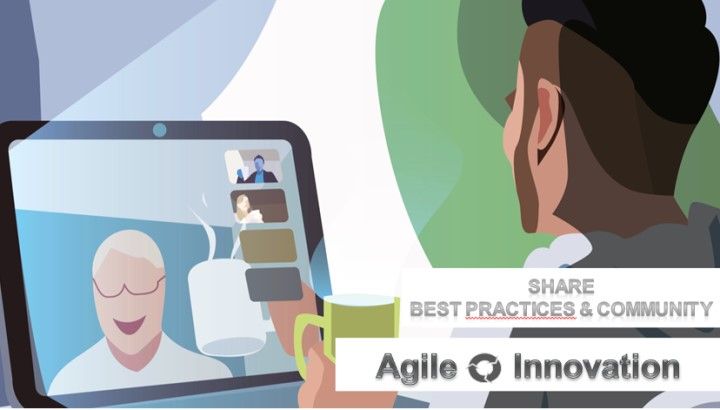25 June 2021
The bet - Improve innovation by using agile methods?
So I started reading through the Agile Manifesto and understood that Agile focuses on the team, its members and an active people exchange. "If you want to change the world, start with yourself" – in fact one of the major agilization challenges in our current transformation to an agile way of working.
To convince him, I started my first thesis “Agile promotes innovation”
I said: From an agile transformation perspective, agility must not "only" increase internal efficiencies, but must create the basis for us to use the gained efficiency for our future success. The experience shows: Increased agility alone is not enough for promoting innovation, we have to change ourself to
- think outside the box of everyday activities,
- understand exciting new technological developments and also the new lifestyles and security needs of our current and future customers
- change ourselves to participate of all changes in our customer segments and even think ahead.
Going ahead I set up my second thesis “Straight innovation processes do not lead to successful ideas”
I tried to convince him by saying: Let's take a look to the dynamics and learning ability of Insurtech startups: They show us that small, fast-learning and entrepreneurial units can identify and develop successful offerings to customer needs compared to large corporations. However, they also show us how we can use our skills, expertise and millions of customer relationships to develop successful new offers by ourselves.
The experience from various hackathons and idea competitions is teaching us: Innovation needs freedom, instead of rigid processes. "Just do it" - this motto should encourage employees to learn from mistakes, instinctively develop innovative solutions and strengthening the own flexibility and changeability.”
A successful innovation method (not innovation process!) is build on methods from lean startup and design thinking to develop approaches for products, services, customer applications or internal improvements. Our most important "capital" are the experiences, challenges and ideas of our employees. Our most important “tool” is an in-depth understanding of our customer needs.
Convincing conclusion
So finally my colleague agreed to my thesis by saying: Being agile does not automatically lead to innovation. Innovation culture and living an agile mindset creates freedom for colleagues and teams with the backing of management "just let do it". The courage and flexibility of the employees are just as important as learning from mistakes, not least the same culture of mistakes. Agilization and innovation are mutually dependent and are in a positive interrelationship. Successful innovation often uses agile methods (e.g. Scrum, Lean Startup, Design Thinking, Design Sprints) and agile teams with the Generali innovation method (not process) are often more successful.

Read the story in original language
The bet - Improve innovation by using agile methods ?
A few years ago a colleague and I discussed about how to improve innovation by using agile methods. He said “No way” – I said “Yes – it works !”
So I started reading through the Agile Manifesto and understood that Agile focuses on the team, its members and an active people exchange. "If you want to change the world, start with yourself" – in fact one of the major agilization challenges in our current transformation to an agile way of working.
To convince him, I started my first thesis “Agile promotes innovation”
I said: From an agile transformation perspective, agility must not "only" increase internal efficiencies, but must create the basis for us to use the gained efficiency for our future success. The experience shows: Increased agility alone is not enough for promoting innovation, we have to change ourself to
- think outside the box of everyday activities,
- understand exciting new technological developments and also the new lifestyles and security needs of our current and future customers
- change ourselves to participate of all changes in our customer segments and even think ahead.
Going ahead I set up my second thesis “Straight innovation processes do not lead to successful ideas”
I tried to convince him by saying: Let's take a look to the dynamics and learning ability of Insurtech startups: They show us that small, fast-learning and entrepreneurial units can identify and develop successful offerings to customer needs compared to large corporations. However, they also show us how we can use our skills, expertise and millions of customer relationships to develop successful new offers by ourselves.
The experience from various hackathons and idea competitions is teaching us: Innovation needs freedom, instead of rigid processes. "Just do it" - this motto should encourage employees to learn from mistakes, instinctively develop innovative solutions and strengthening the own flexibility and changeability.”
A successful innovation method (not innovation process!) is build on methods from lean startup and design thinking to develop approaches for products, services, customer applications or internal improvements. Our most important "capital" are the experiences, challenges and ideas of our employees. Our most important “tool” is an in-depth understanding of our customer needs.
Convincing conclusion
So finally my colleague agreed to my thesis by saying: Being agile does not automatically lead to innovation. Innovation culture and living an agile mindset creates freedom for colleagues and teams with the backing of management "just let do it". The courage and flexibility of the employees are just as important as learning from mistakes, not least the same culture of mistakes. Agilization and innovation are mutually dependent and are in a positive interrelationship. Successful innovation often uses agile methods (e.g. Scrum, Lean Startup, Design Thinking, Design Sprints) and agile teams with the Generali innovation method (not process) are often more successful.

